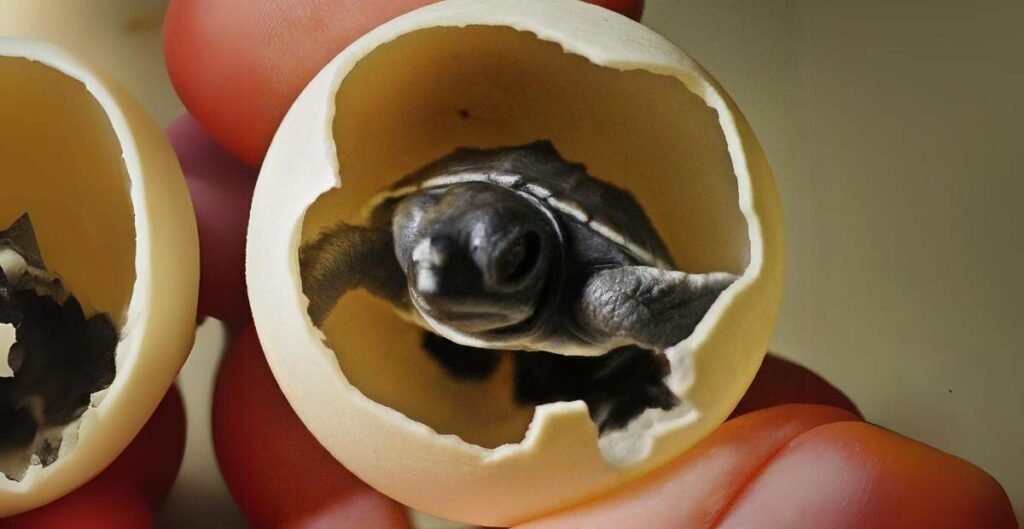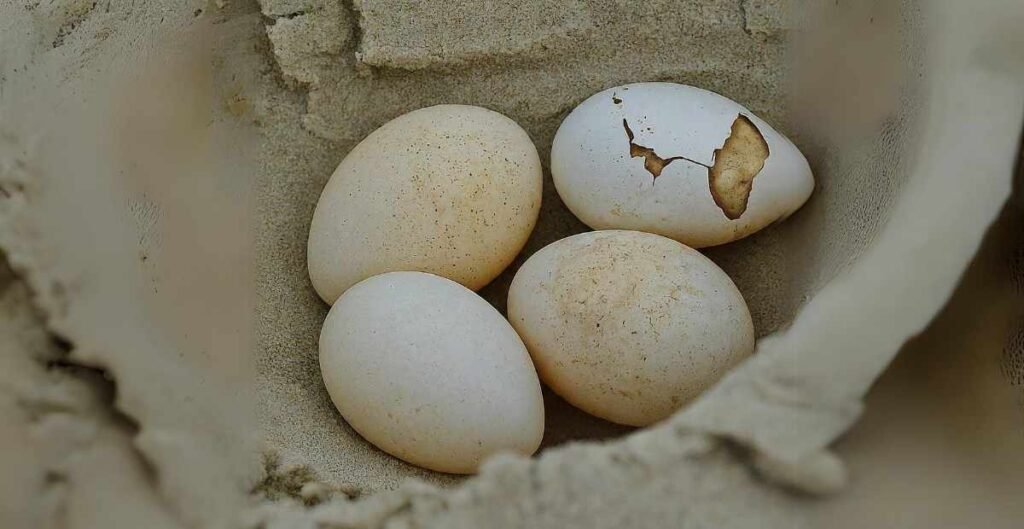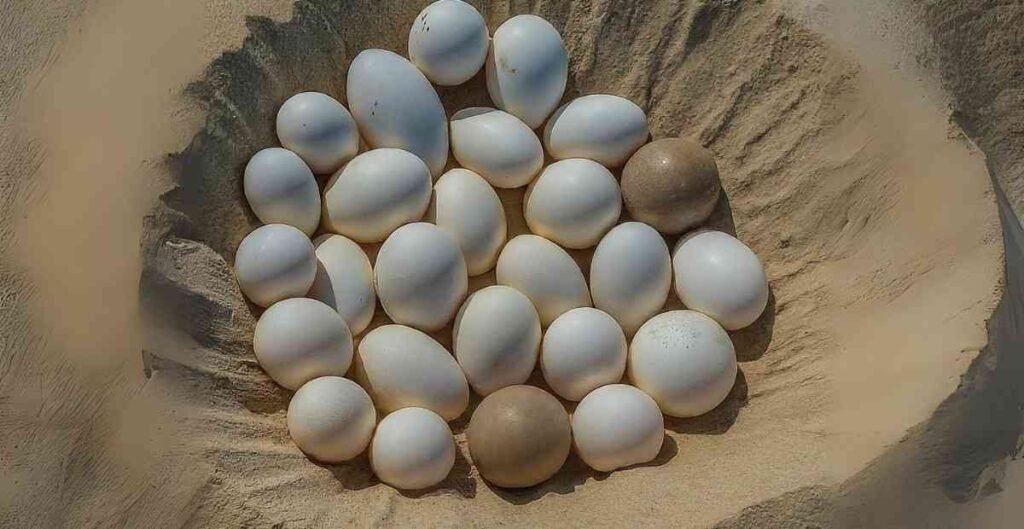If you are a turtle enthusiast, this question may interest you – how long does it take for turtle eggs to hatch? Based on the different turtle species, the hatchling process varies. Generally, turtles go through several processes to reproduce. First, they mate, most probably in spring. Then, they may have to go through brumation. It’s a process of slowing down the metabolism to survive underwater.
After they lay eggs, they find a suitable area to dig their nest and keep the eggs safe. Then, the adult turtles hatch or incubate the eggs so that the babies come out in proper condition. Today we will explore this query in detail – how long does it take for turtle eggs to hatch?
Table of Contents
How Long Does It Take for Turtle Eggs to Hatch?

For turtle eggs hatchling time time, there is no one answer. Because it depends on the species they belong to, the temperature they are living in, the depth of their nest, and many more. This entire process can take 45 to 90 days, depending on different types of turtle species, environmental conditions, and nest depth.
What Is The Process Before Turtle Eggs Hatchling?
Like any other living species, before egg laying and hatchling, the first reproduction process is mating. A turtle mating ritual usually takes place in water, where the males woo the females. After successful mating, female turtles head to land to lay their eggs. To dig their nests, they choose sand or soft soil, and they choose the nesting site carefully to avoid predators. So the eggs will grow in a safe environment.
The incubation period for turtle eggs varies by species, but it usually lasts 45 to 65 days, as we already mentioned. During incubation, the temperature of the nest determines the hatchlings’ sex.
Now, let’s discuss what factors can influence the turtle egg incubation period.
What Are The Factors Influencing The Incubation Period?

Turtles’ egg hatchlings depend on various factors. Let’s see most of the crucial factors that contribute to turtles hatchling time –
Temperature
Temperature has a great hand in turtle eggs’ hatching. Certain turtle species need a specific temperature range to hatch. For example, green turtles require 30 to 33 degrees Celsius to hatch. Then, Loggerhead turtles require 25 to 30 degrees Celsius to hatch.
If the temperature is ideal, turtles can hatch their eggs within two days. Meanwhile, 24 to 32 degrees Celsius is the optimum temperature for these creatures to hatch their eggs quickly.
Humidity
Like temperature, humidity plays a crucial role in promoting the hatching of turtle eggs. If the humidity is less, the eggs will dry out, and if the humidity is high, harmful bacteria will come in. Well, it’s advisable to keep the humidity level from 70% to 90%. You can use a hygrometer to determine the humidity level of turtles’ eggs.
Nest Depth
Nest depth is another unavoidable factor to ensure proper and safe hatching of eggs. Deeper nests attract moisture from sand and soil, leading to stable temperature and humidity for the eggs. The turtles, inside, will find it more comfortable to develop their embryos. Apart from that, a higher depth in a turtle nest ensures safety from their predators.
Now, what’s the preferred depth for a turtle nest? Well, it’s better to keep 40 to 70 centimetres deeper inside the ground.
What are the Average Incubation Periods for Different Turtle Species?

We already talked about different species’ varied incubation periods. Here are some of the various turtle species’ estimated incubation periods –
Sea Turtles
Sea turtles are divided into various species. So, they all won’t have the same period for incubation. However, the shortest period is 45 days, and the longest period is 90 days, whereas their average incubation period is 2 months. Now, why do their incubation periods vary? It’s because of the temperature, humidity, and nest depth, which we already discussed. However, the preferable temperature for sea turtle incubation is 82 to 88 degrees Fahrenheit.
Box Turtles
The period of incubation for box turtles starts after completing their hibernation. Their general time to lay eggs is May to July, and the baby turtles will most probably come from August to October. However, box turtles’ incubation period ranges from 50 to 90 days.
Snapping Turtles
Nocturnal turtles, like snapping turtles, prefer living underwater. In a single clutch, they can lay up to 40 eggs. If everything goes right, they will hatch their eggs in July to October. Their incubation period can take 80 to 90 days.
Red-Eared Sliders
The mating time of red-eared sliders is May to June. Then, they show up their hatchlings in July to September. Red-eared sliders hatching or the incubation period lasts for 60 to 90 days.
How Do Environment and Biology Affect Turtle Egg Hatching Time?
So, is there any other effect on egg turtle hatchling time or final results? Yes, there are. Let’s see what they are –
Temperature-Dependent Sex Determination
Temperature is a deciding factor for the upcoming hatchling turtle that determines its gender. For example, turtle eggs that hatch in high temperatures result in female turtles, and turtle eggs that hatch in low temperatures result in male turtles.
Predation and Human Impact
Many predatory birds have sharp eyesight. Their job is to target turtle eggs and nests to feed on. With their sharp beaks, they destroy turtle nests and consume their eggs. Opossums and raccoons are other turtle predators. They have dexterous paws, making them dog out turtle eggs and nests.
Like these creatures, humans are also responsible for reducing the turtle population. For example, nowadays, humans are more interested in recreating beaches, developing coastal areas, etc. These activities are destroying the turtle’s lives and their ability to hatch eggs.
To keep the turtle population stable, people are now implementing many conservation efforts. One such is the nest relocation that involves shifting the turtle eggs to a safe place. Another step is creating barriers around the eggs with wires so that predators can’t come in.
How to Conserve & Keep Turtles Eggs Safe?

Turtles’ lives and their egg’s existence are vulnerable to human activities, predator risks and climate change. Let’s shortly talk about how we can protect them.
Nest Relocation and Protection
As said already, nest relocation is a prime step in conservation and management strategies to save turtle eggs. This step includes relocating the nests for optimum incubation. Thus, these can be out of risk from natural calamities, predators, and other threats.
Now, some educational programs are also coming forward. They are building workshops and engaging with community members. Then, some community engagements involve partnering with stakeholders that are related to turtle inhabitants.
Climate Change Impacts
Climate change is affecting the sex ratio in turtles. How? Eggs hatch into female turtles when the temperature is higher. Meanwhile, the climate of the world is getting more humid and hot, resulting in female turtles hatching. If the number of only females turtle increases, they can’t reproduce the significant number of turtles.
And we know turtles play a great role in maintaining the coastal and marine habitats. Thanks to the conservative organizations that are working to mitigate the impacts on turtles’ sex ratios. Their adaptive management techniques are helping to balance the climate to a certain level and balance the turtle population.
FAQs
How long do turtle eggs take to hatch?
The period of hatching of turtle eggs depends on temperature, humidity, and many other factors. But their general timing is 45 to 90 days.
How long does it take for mud turtle eggs to hatch?
Mud turtles can show up from July to October. They take 90 to 120 days to hatch them.
How long do painted turtle eggs take to hatch?
Summer and spring are the times for painted turtles to hatch eggs. However, their incubation period lasts from 70 to 80 days, depending on the environmental conditions.
Wrap Up
So, how long does it take for turtle eggs to hatch? It can be 45 days if the temperature, safety of the nest, the species, and everything else suit it to hatch fast. And sometimes, it can even take 90 days if the temperature is cold, the species has certain aspects, and many more. Also, their incubation process determines how the turtle will be. Male or female, healthy or abnormal, etc.
Since turtles are maintaining our ecosystem, it’s our duty to make conservation efforts to save them. For example, we can relocate their nests, create barriers around the eggs and nest, and try to improve the environment to make the climate better for these creatures.
